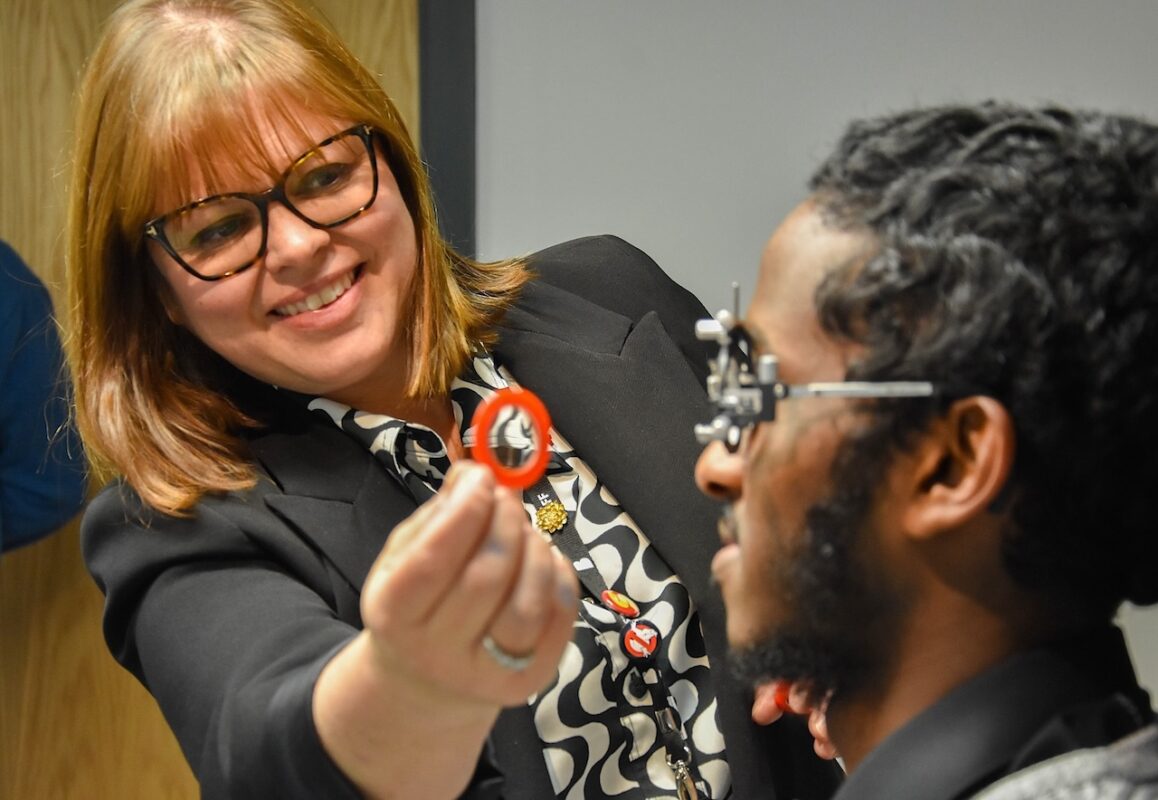Associate continuing healthcare practitioner

KSBs
Knowledge
K1: Understands the structures and functions of the human body Back to Duty
K2: Understand how to support people going through the Continuing Healthcare process Back to Duty
K3: Understand commonly encountered mental, physical, behavioural and cognitive health conditions, medication usage and treatments and and how ill health impacts on the individual and their family Back to Duty
K4: The principles of infection control Back to Duty
K5: Understand the principles of Funded-nursing care and Joint packages of care and how the Associate Continuing Healthcare Practitioner can support the planning and assessment of these Back to Duty
K6: Knows how and when to plan and facilitate referal, discharge or transition of care between professionals, settings or services and what makes up an appropriate care package Back to Duty
K7: Understands the principles of a primary health need and the difference between health and social care needs Back to Duty
K8: Understand the importance and how to use a range of communication methods and media available to assist with communication Back to Duty
K9: The range of health and social care contract types used, including Personal Health Budgets and services commissioned to treat and support individuals with ill health, disabilities and social care needs Back to Duty
K10: Knows the principles of healthcare business and financial planning, commissioning and procurement and how this impacts on continuing healthcare services and the numeracy to undertake basic budgetary analysis. Back to Duty
K11: Understand the impact of co-morbidities and the demands of meeting people’s complex health and social care needs when commissioning services Back to Duty
K12: How to undertake risk assessment, using a range of commonly used tools, and know when to seek advice to avoid compromising quality and safety of others Back to Duty
K13: Understands the factors which affect vulnerable people and how this can impact on the health and social care needs and the role of safeguarding policy in oversight of their care Back to Duty
K14: Understand the differences between risk aversion and risk management and how to avoid compromising quality of care commissioned but work towards the choices of the individual where safe to do so Back to Duty
K15: Understand the role and function of the Care Quality Commission for care home, supportive living and home care providers Back to Duty
K16: Understand the importance of Contractual Management in maintaining the quality, sustainability and effectiveness of services and what contractual levers can be used if concerns are identified Back to Duty
K17: Knows how discriminatory behaviour is exhibited and the impact this can have on individuals and the commissioning function Back to Duty
K18: Techniques to manage differences of opinion, conflict and difficult conversations between professionals Back to Duty
K19: Understand the principles of accountability and how this applies to the role of Associate Continuing Healthcare Practitioner Back to Duty
K20: Understands the principles of courage, transparency and the professional duty of candour Back to Duty
K21: Knows how care navigation/social prescribing can be used to address the individual’s needs and support them to move from dependence to more independence Back to Duty
K22: Understand roles, responsibilities and models of care of all members of the health and social care multidisciplinary team in providing and commissioning care and how the MDT contribute to a lawful assessment for eligibility of Continuing Healthcare Back to Duty
K23: Understand the principles of effective leadership and supervisory opportunities and roles for a associate continuing healthcare practitioner Back to Duty
K24: Understand the demands of multidisciplinary practice and strategies to develop resilience in self and know how to seek support to help deal with uncertain situations Back to Duty
K25: Understand relevant legal, regulatory and governance requirements, policies, and frameworks, including any mandatory reporting duties, to all areas of practice Back to Duty
K26: Knows the financial implications that eligibility has and how this can influence demand on the service, behaviours and decisions made Back to Duty
K27: Knows how to critically appraise and reflect upon knowledge, research and practice and understand how this can be used in practice improve the quality of care and service delivered and commissioned Back to Duty
K28: The importance of accurate and timely data collection processes and how this has an impact on local and national assurance mechanisms Back to Duty
K29: Know how to review individual’s health and social care needs related to breathing, nutrition, bladder and bowel health, skin integrity, mobility, communication, psychological and emotional, cognition, behaviour, symptom control and consciousness Back to Duty
K30: Understand the challenges of providing safe care for people with complex co-morbidities and complex care needs Back to Duty
K31: Understands methods for dealing with potential conflict situations Back to Duty
K32: Recognises the impact of claims companies and solicitors on the appeals process Back to Duty
K33: Understands the roles, responsibilities and functions of the Health and Social care professionals that form a MDT Back to Duty
Skills
S1: To make appropriate referrals of an individual into the continuing healthcare service via a standard or fast-track referral pathway, using the mandated screening tools as per national policy, rejecting and redirecting any inappropriate referrals Back to Duty
S2: To formulate, monitor and reassess person-centred, evidence based health and social care plan, delegated by registered practitioner, ensuring commissioned services maintain optimal independence and health and social care outcomes where possible and continues to meet the needs of the individual Back to Duty
S3: Take appropriate action where change in health or social care need requires screening, referral or further MDT assessment to establish ongoing Continuing Healthcare eligibility Back to Duty
S4: Co-ordinate routine planning and management of referral, discharge or transition of care between professionals, settings or services Back to Duty
S5: Protect health through applying the principles of infection prevention and control Back to Duty
S6: Communicate and provide information in an accessible way that is sensitive and appropriate, using a range of skills and strategies with colleagues and people at all stages of life and with a range of mental, physical, cognitive and behavioural challenges recognising common barriers to communication Back to Duty
S7: Utilise report writing skills to formulate clear and evidence based multidisciplinary team recommendations Back to Duty
S8: Develop, manage and maintain appropriate relationships and rapport with people, their families, carers, colleagues and providers Back to Duty
S9: Facilitate discussions with individuals and their families to set an indicative Personal Health Budget Back to Duty
S10: Identify responsible commissioner for individuals referred into the continuing healthcare service Back to Duty
S11: Commission a package of care for an individual eligible for continuing healthcare Back to Duty
S12: Manage and prioritise competing demands, prioritising workload based on level of risk Back to Duty
S13: Process referrals in a timely manner Back to Duty
S14: In a range of settings, recognise where people could be at risk, including from neglect, and take appropriate action to report potiential risk for assessment Back to Duty
S15: Commission safe, effective and person-centred health and social care packages for people who have co-morbidities and complex care needs Back to Duty
S16: Participate in data collection to support service delivery evaluation, audit or assurance activity to identify appropriate quality improvement activities or any gaps within the provider market Back to Duty
S17: Works within limits of own competence, experience and training, delegating tasks and escalating issues and duties appropriately Back to Duty
S18: Act as an advocate for the individual Back to Duty
S19: Use facilitation and co-ordination skills to make best use of the contributions of others across the multidisciplinary team for the purposes of a lawful assessment or review Back to Duty
S20: Apply the principles of effective leadership Back to Duty
S21: Act as a role model to colleagues, supervising and providing feedback about behaviour and actions of others, motivating them to reflect on and develop their practice Back to Duty
S22: Ensure the wellbeing and resilience needs of the team are met and recognise signs of vulnerability in themselves or their colleagues Back to Duty
S23: Act in accordance with legislation, national guidance and local policy at all times Back to Duty
S24: Can proactively engage with the individual or representative to support an amicable and lawful resolution of conflict or disagreement Back to Duty
S25: Identify and collate documents and evidence demonstrating current health and social care need from all professionals involved in the care of the individual, for lawful assessment or review of health and social care need to be undertaken Back to Duty
S26: Use a range of digital technologies to access, input, share and apply information and data within teams and between agencies Back to Duty
S27: Complete, store and retain accurate and contemporaneous records and data Back to Duty
S28: The ability to read, interpret and understand clinical records and notes Back to Duty
Behaviors
B1: Act in a non-discriminatory fashion, treating people with dignity and respecting individual’s diversity, beliefs, culture, needs, values, privacy and preferences Back to Duty
B2: Be caring, sensitive and compassionate, nurturing the potential in others Back to Duty
B3: Have the courage to speak up and challenge areas of concern or any discriminatory behaviour, providing honest, accurate and constructive feedback Back to Duty
B4: Be competent, reliable and committed, using reflection to constantly improve and work to evidence based best practice always working within limits of own competence, experience and training Back to Duty
B5: Be adaptable, reliable and consistent, show discretion, resilience and self-awareness and demonstrate leadership Back to Duty
B6: Communicate in ways that are sensitive and appropriate, considering emotional, psychological, cognitive, language, social and other circumstances Back to Duty
B7: Constantly works to build the development of a positive associate CHC practitioner-patient relationship as a core element of the role Back to Duty
B8: Act as an ambassador and promote trust, upholding the reputation and promoting public confidence in the continuing healthcare service Back to Duty
B9: Demonstrates accountability in practice, engaging proactively in continuing development and training Back to Duty











Responses